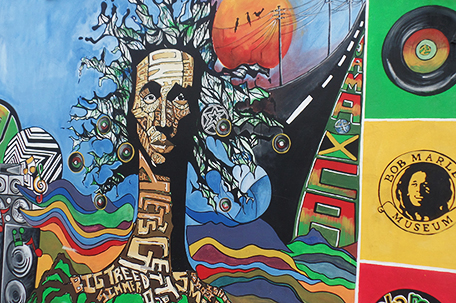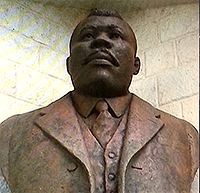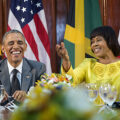
ABOVE PHOTO: Marley Museum gate mural (Photo: Renée S. Gordon)
By Renée S. Gordon
“In this bright future you can’t forget your past.” –Bob Marley
For a brief orientation on what is most wonderful about Jamaica and its people one need look no further than the Jamaica National Flag. It was designed by a committee of the Jamaica House of Representatives and first flew on August 6, 1962, Jamaican Independence Day. The three colors and four triangles used in the design are representative of the nations’ past and future. Two green triangles on the top and bottom stand for the hope of the people and the country’s agricultural bounty. The gold swaths that separate the triangles embodies the wealth of natural resources and the sunlight that bathes the island in a gilded aura and the two black triangles symbolize the people and their legacy of strength and creativity.
All of these qualities can be found all over the island but to visit Kingston is to explore the most culturally diverse and culturally rich area in the country. Situated on the southeastern coast of the island the Jamaican capital is also its largest city. Kingston was founded on July 22, 1692 after an earthquake and tsunami destroyed Port Royal, leaving more than 2,000 dead and for any survivor to relocate. Port Royal was established in 1518, 174 years before Kingston, but Jamaica’s biography begins long before that.
Jamaica is part of an extensive string of volcanic mountains that line the bottom of the Caribbean Sea with mountaintops that, in some cases, rise above the water and form islands. Jamaica rose and submerged several times during its formation and limestone covered vast areas forming caves and hidden rivers. The entire Caribbean is referred to as the West Indies with Jamaica being one of a subset of islands known as the Greater Antilles.
The Arawak, or Taino, Indians arrived on the island around 2,500-years ago from South America. They settled along the shoreline and fish became a dietary staple. They grew cassava, cotton, tobacco and vegetables and named the island Xaymaca after its chief resources, “wood and water.” On May 4, 1494 Christopher Columbus sailed into what is now St. Ann’s Bay on his second voyage but was unable to land. He sailed on to Discovery Bay where he landed and claimed the island for Spain. Jamaica for the next 15-years served as a provisioning base and point from which the Spanish could mount conquests. Columbus named the island Santiago, St. James, but the original name is the one by which it has always been known.
Governor Juan de Esquivel and a group of settlers founded Sevilla la Nueva in 1509 followed by other small villages. In the 1520s, St. Jago de la Vega was developed as the first capital with trade and government functions taking place there. Esquivel was responsible for the earliest slave trade when he immediately began enslaving the island’s indigenous people and sending most to Hispaniola and Spain, but retaining some to labor on the island. Eventually, when the Arawaks and indentured servants proved inadequate as workers the Spanish turned to Africans, when were seen as cheaper and in a seemingly endless supply. The chief crop of the island, and most of the Caribbean, was sugar, a crop that was so labor intensive that the life expectancy was only 7 years for workers.
King Ferdinand granted permission for Christian blacks to be transported from Spain, not Africa, to Jamaica as slaves in 1501. Africans were not brought into the colony until an asiento, a contract, allowed importation of 4,000 blacks annually from Africa over a 4 year period. King Charles I signed it in 1518 and by the early 17th-century the island’s population was 50 percent free and enslaved blacks. It is estimated that more than one million slaves were transported to Jamaica directly from Africa before the slave trade ended in 1834. British forces landed in Jamaica on May 10, 1655 under the leadership of Adm. William Penn, father of Pennsylvania’s founder, and Gen. Robert Venables and claimed it for England.
The Jamaican Assembly first met in Kingston in 1755 but, curiously, documents fail to tell us where. In 1814 the Assembly moved to Hibbert House and the government purchased the structure in 1872. Headquarters House, as Hibbert is now known, was the Legislature’s home until 1960 when it was relocated to George William Gordon House. Hibbert House now houses the National Trust of Jamaica and the 2 story Flemish-bond residence has been extensively remodeled. jnht.com
The house, a masterpiece of 18th-century Jamaican architecture, was constructed by Thomas Hibbert to win a bet as to which of four planters could build the most stunning mansion. The prize was the hand in marriage of the town beauty. Hibbert came to Jamaica in 1734 to protect his family’s interests in the slave trade and became personally wealthy doing it. He won the bet in 1755, but declined the marriage and opting to form a relationship with his beautiful, educated, enslaved housekeeper Charity Harry. Charity and Thomas had three daughters, all well educated, one of whom was an art student of Sir Joshua Reynolds. Hibbert continued to own nearly 1,000 slaves on his plantation properties. Charity was at his bedside when he died.
Gordon House, the Jamaican Parliament, Building, is located adjacent to Hibbert House. The two story. L-shaped, contemporary building is named in honor of national hero George William Gordon. Born of an enslaved mother and a planter he became a self-taught lawyer, landowner and political activist who urged resistance by the underprivileged. He was charged with insurrection and treason in relation to his supposed role in an insurrection at Morant Bay. He was executed on October 23,1865.
George Stiebel, Jamaica’s first black millionaire, built Devon House in 1881 on the foundations of St. Andrew Parish Church’s rectory. Stiebel was the son of a black Jamaican housekeeper and a German Jew. He left school at 14 to become a carpenter’s apprentice and in his 20s his father gave him money to help him purchase a ship to engage in trade. He soon purchased more ships and engaged in legal trade as well as gun running. In the 1850s he was aboard one of his ships when they sank, washing him ashore in Venezuela. He became a peddler there and accumulated enough profit to become a gold trader and purchase shares in a gold mine. Rich once more, he returned to Jamaica and bought 99 properties because the law did not allow ownership of 100.
The Jamaican Georgian Devon mansion is a consistent recipient of TripAdvisor’s “Certificate of Excellence” and has been visited by numerous international luminaries including Queen Elizabeth. Heritage Tours are offered on weekdays and include 14 of the 24 rooms. The rooms are fully furnished and highlights include an elegant staircase in the vestibule, the Ballroom adorned with an original Wedgewood ceiling and the Sewing Room featuring a staircase that could be pulled up hide an upstairs gambling area. Outbuildings have been repurposed to serve as Courtyard Shops. Both the food and libations are renowned and National Geographic designated Devon House the “4th Best Place to Enjoy Ice Cream”.
Lady Musgrave Road links many of the heritage sites but not Devon House. When George Stiebel constructed the mansion Governor Lord Anthony Musgrave’s wife took umbrage at having to ride pass the home of a black man. Her husband had a road cut for her, Lady Musgrave Road, so that she would not have to feel humiliated. devonhousejamaica.com
National Heroes Park is one of the most visited of the 36 National Heritage Sites in Kingston. The area was once the site of the Kingston Race Course and on August 2, 1838 a large celebration was held here in recognition of the total eradication of slavery and apprenticeship. In 1973, it became the National Heroes Park and monuments were erected to honor the island’s seven heroes, Nanny of the Maroons, Paul Bogle, Alexander Bustamante, Marcus Garvey, George William Gordon, Norman W. Manley and Sam Sharpe. Bustamante, Garvey and Manley are interred there.
In July 2003, Laura Facey’s controversial “Redemption Song” Statue was dedicated in Emancipation Park. Two 7-ft. bronze nudes, a male and female, stand facing each other looking skyward. The dome-shaped base is etched with Garvey’s words that were incorporated in Marley’s Redemption Song, “None but ourselves can free our minds”.
Although slavery officially ended in the 1830s, the underprivileged and disenfranchised failed to gain opportunities. In 1914, Garvey established the Universal Negro Improvement Association (UNIA) and Back to Africa Movement. In 1930, Ras Tafari Makonnen, Haile Selassie, ascended the throne of Ethiopia and was viewed as the fulfillment of a prophecy made by Garvey. It is believed that Leonard Percival Howell founded Rastafarianism in 1935, he wrote the first book on the subject, “The Promised Key,” and he is recognized as the first Rastafarian. Originally one of Garvey’s most important followers he deftly blended the teachings of Garvey, veneration of Haile Selassie and inspired preaching to grow the number of followers.
The most famous Jamaican and Rastafarian is Robert Nesta Marley, OM. He was born in 1945 in Nine Mile, Jamaica but his life is well interpreted in Kingston where he spent the majority of his life.
Jamaica’s Central Housing Authority erected government housing on 200-acres in the 1940s called Trench Town. Renters were provided with water, electricity and a shared kitchen and bathroom facilities for a nominal fee. Apartments consisted of one or two 10-ft. by 10-ft. rooms. Trench Town Culture Yard (TTCY) area was part of the “U” block of homes, 16 rooms with 16 families, around a communal courtyard. It was here that 11-year old Bob Marley and his mother moved in 1956 and it was here that his legend began.
Bob Marley was taught to play the guitar by one of the residents, Vincent Ford, the Wailers were formed here, he and Ford composed No Woman No Cry and he recorded his first album, Catch a Fire. In 2007 TTCY was granted protected National Heritage status. www.bobmarley.com
Guided tours are regularly scheduled and are a wonderful experience. Several of the rooms form a museum that exhibits photographs, artifacts and makes clear the fact that a number of noted musicians, activists and artists lived here, Marley was merely the most famous. On exhibit is Marley’s first guitar. Two rooms of particular note are Ford’s room, outfitted with a bed, walls covered with Biblical scripture, his personal Bible turned to psalm 68 and the kitchen that was used by Bob Marley as a bedroom featuring his original bed. Marley’s father, Captain Norval Marley, was a white Englishman in his 50s and his mother was 16. He never met his father and, as an adult, he sought out his English family but they refused to acknowledge him. Captain Marley’s photograph is displayed.
In the courtyard guests can take pictures with a statue of Marley and the remains of his first car. Marley’s early recording studio still functions and if you visit on a recording day you are welcome to enter the studio and watch. trenchtowncultureyard.com
The Bob Marley Museum is part of a complex that includes a theater, recording studios, café, exterior art exhibits and Marley’s home from 1975 until his death from cancer at the age of 36 in 1981. The house was purchased from his manager and retains original bricks, marble steps and sashes.
Guided interior tours are 1.5-hours and showcase Marley’s awards, honors, career, personal items and lifestyle. Tours begin with the biographical murals on the exterior and the statue in front of the residence that includes portraits of Garvey and Selassie. Also highlighted are his favorite spot to compose music and the place on the porch where he held interviews. Showcased areas inside the museum are a room wallpapered with articles that relate his career from 1973 to 1981, a stage backdrop, bedroom in which he died, his kitchen still filled, with his personal utensils and the studio in which he recorded three albums. The last stop on the tour is a visit to the rehearsal room where the assassination attempt was made on his life in December 3, 1970 accessed through the yard. bobmarleymuseum.com
Bob Marley founded Tuff Gong International in 1965 and gave the enterprise his nickname. It is a full-service, state-of-the-art recording studio and tours can be arranged. tuffgong.com
The Jamaica Music Museum (JaMM) is a section of the Institute of Jamaica. The exhibits are undergoing installation and will reopen in 2016 to continue its mission to serve as the national repository for information and artifacts interpreting all genres of Jamaican music and music heritage. jamm-ioj.org.jm
Now that you have toured Jamaican musical history it is time to experience it. Redbones Blues Café, a Jazz & Blues themed Caribbean Fusion Cuisine Restaurant & Bar is renowned as both an entertainment and dining venue. It opened in 1996 with a name that reflects Jamaica’s mixed racial heritage with private gardens and terraces, casual elegance and gourmet cuisine add to the ambiance. redbonesbluescafe.com
Knutsford Court Hotel provides perfect accommodations for the Kingston portion of your visit to Jamaica. It offers 143 rooms and suites with all the amenities including free WIFI, complimentary full buffet breakfast and electronic key access to rooms and secure areas of the hotel. The Knutsford is located five miles from the airport in the heart of downtown and within walking distance of many sites and shopping. The Melting Pot, the onsite restaurant, looks out on a tropical garden. Service throughout the hotel is exemplary. knutsfordcourt.com
Several airlines are offering sale fares to Jamaica and this is the time to go. Meteorologists predict that our winter will be extremely cold. I predict that you will find a warm welcome in Jamaica. Visitjamaica.com
I wish you smooth travels!

















Leave a Comment